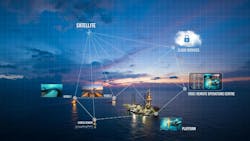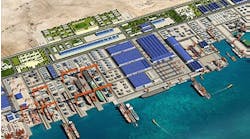Navigating bandwidth challenges in offshore energy environments
Editor's note: This article first appeared in the 2024 Remote Inspections & Operations Special Report, which published within the January/February 2024 issue of Offshore magazine.
By Paul Guilfoyle, Harvest Technology Group
The offshore and energy industries are on the cusp of a paradigm shift as they look to remote technologies to bolster safety measures and augment operational efficiency. Ground-breaking innovations in remote inspection and surveillance are transforming the landscape of asset integrity management, resulting in decreased downtime and improved worker safety in the challenging and dynamic offshore environments.
A pivotal challenge facing remote offshore operations and uncrewed technology lies in the need for real-time communications for accurate, timely decision-making. Offshore operators need connectivity to be available, reliable and able to instantly transmit large packets of data between onshore and offshore. Isolated locations, harsh weather and powerful seas, however, are challenges to connectivity. Despite some solutions showcasing good download speeds, they often miss the mark due to insufficient upload speeds, unreliable connections, high costs, packet loss, patchy security and latency, which hinder operational efficiency and data integrity.
Effectively addressing these challenges is crucial for transmitting information that increasingly includes video, audio and data from remote offshore sites over ultra-low bandwidth or unreliable connections. Optimizing network capabilities is key. By integrating the right software and hardware into the operators own technology, they can navigate the bandwidth challenges of offshore environments to have situational awareness for real-time decision-making.
Geodata specialist Fugro exemplifies the growing trend toward remote inspections and operations. Their shift to an uncrewed fleet for offshore operations necessitated continuous 24/7 visibility and remote inspections of assets. Fugro integrated Harvest Technology Group’s Nodestream and RiS (remote inspection systems) technologies into its network and asset environments.
This integration allowed Fugro to perform remote subsea inspections of offshore assets through live-streamed high-quality 4K video, audio and data in real time, eliminating the need for large project teams and crew, while also enabling smaller vessel support. Additionally, it mitigated the necessity to send personnel into unsafe environments or require them to travel to/from remote locations.
Through the remote management of unmanned surface vehicles (USVs) and the use of smaller vessels, Fugro achieved a reduction of more than 90% in CO2 emissions compared to traditional vessel operations. The USVs could operate over extended distances with minimal latency, allowing for up to 90% packet loss without loss of control. This reliability over low-bandwidth connections translated into significantly improved operational efficiency.
By utilizing Harvest’s technology for remote inspection projects, Fugro’s customers collectively realized cost savings exceeding $200 million and a reduction of more than 5 million HSE exposure hours in the field.
As the shift toward optimizing networks for offshore remote inspections and operations continues, it is not a culmination but rather the inception of a transformative era. Forward-thinking offshore and energy operators are extending their gaze beyond the seas and into the cloud. The power of AI and on-demand unified communications will redefine the boundaries of offshore operations.



